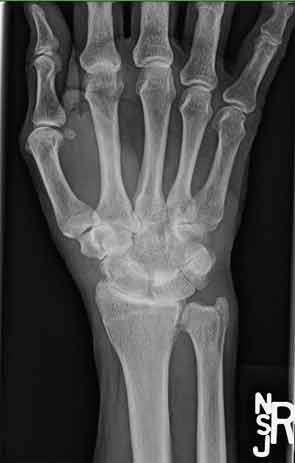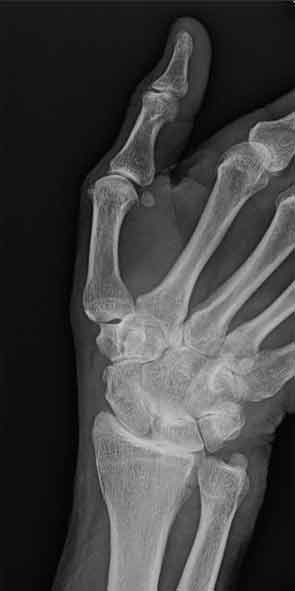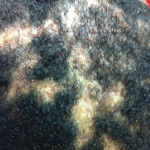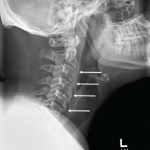A rheumatologist at another medical center recommended treatment with adalimumab. This initially produced considerable relief of her chest pain. However, because of a prior history of malignant melanoma, it was recommended that treatment with anti–tumor necrosis factor (TNF) drugs be discontinued. The patient could not tolerate treatment with colchicine. A course of weekly methotrexate was not helpful and was discontinued after several months. She continues to complain of severe anterior chest pain.
Patient 3
A 70-year-old male developed fever, malaise, and painful swelling in the right wrist and the left sternoclavicular joint. Computed tomography, MRI, and bone scans suggested osteomyelitis in the left sternoclavicular joint (see Figure 3). Radiographs of the right wrist demonstrated intercarpal narrowing (see Figure 4). The patient underwent surgical exploration of the sternoclavicular joint, and the surgeon commented on the appearance of a “thick, cheesy” mass. The histopathology of this lesion demonstrated changes consistent with chronic inflammation and osteomyelitis. Multiple microbial cultures were sterile. The patient was treated with low-dose corticosteroids and a single dose of pamidronate with dramatic improvement in his symptoms.


Discussion
The acronym SAPHO was coined in 1987 to describe a very heterogeneous disorder that typically affects young adults but can also occur in children and the elderly. It is somewhat similar to chronic recurrent multifocal osteomyelitis (CRMO), which was first described in children in 1972. CRMO and SAPHO are syndromes (i.e., constellations of signs and symptoms in recognizable patterns) rather than well-defined clinicopathological diseases. Whereas CRMO usually involves the long bones in a symmetrical pattern, with little involvement of the jaw and sternum, SAPHO typically affects the anterior chest wall, axial skeleton, and the jaw.
Patients may present with a combination of skin lesions, arthritis, and musculoskeletal pain. As in psoriatic arthritis, the skin lesions may occur before, after, or concurrent with the musculoskeletal manifestations. A variety of skin lesions can occur (see Table 1). Palmar plantar pustulosis (PPP) is localized pustular psorisasis on the palms and soles. More diffuse pustular psoriasis may be seen, or psoriasis vulgaris with the typical plaque-like lesions. Acneform lesions are also common. Acne conglobata presents with comedones, draining sinus tracts, nodules, and abscesses. Acne fulminans is an acute, febrile, ulcerative process, often associated with infection with Propionobacterium acnes. The sweat glands and sebaceous glands are common sites for P. acnes, thought to be potentially pathologic in SAPHO syndrome. Hidadrenitis suppurativa involves the apocrine sweat glands or sebaceous glands, in the axillae, inframammary regions, inner thighs, groins, and buttocks. Chronic abscesses as well as sebaceous and pilonidal cysts are seen.


